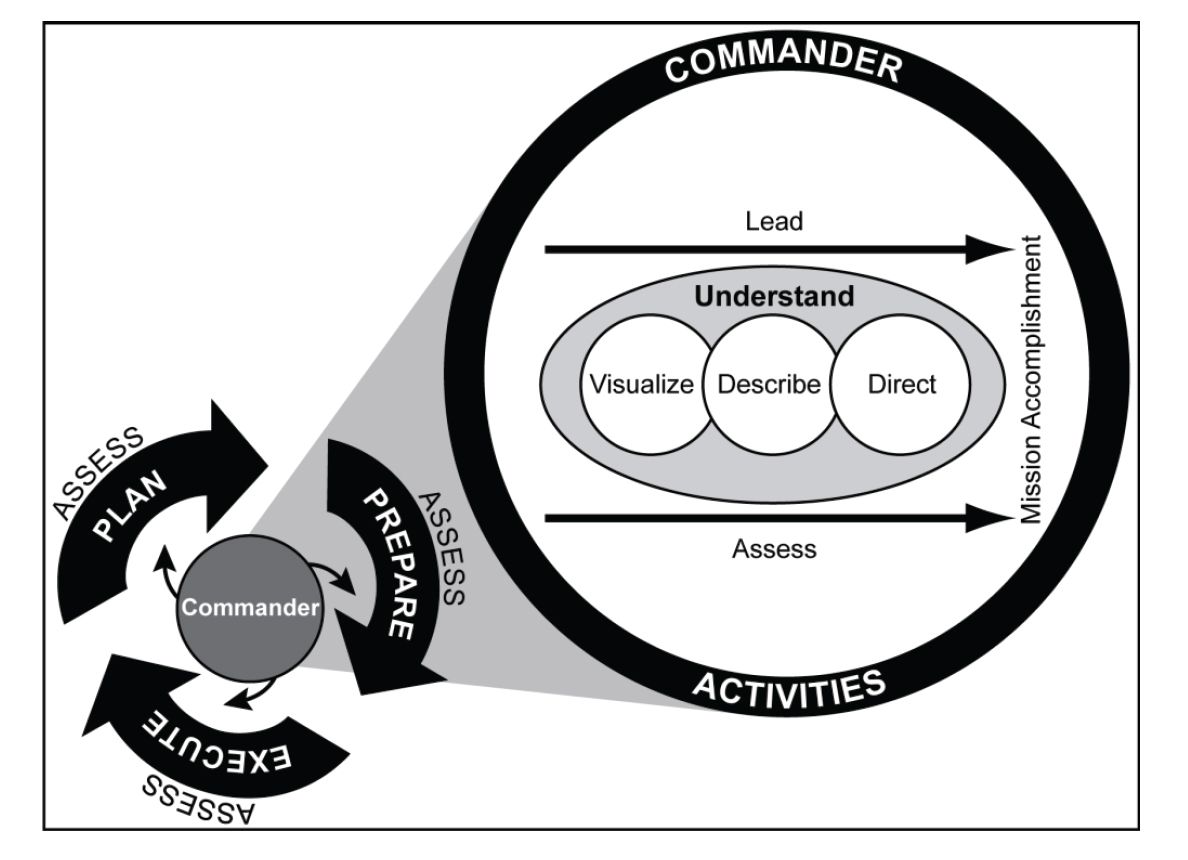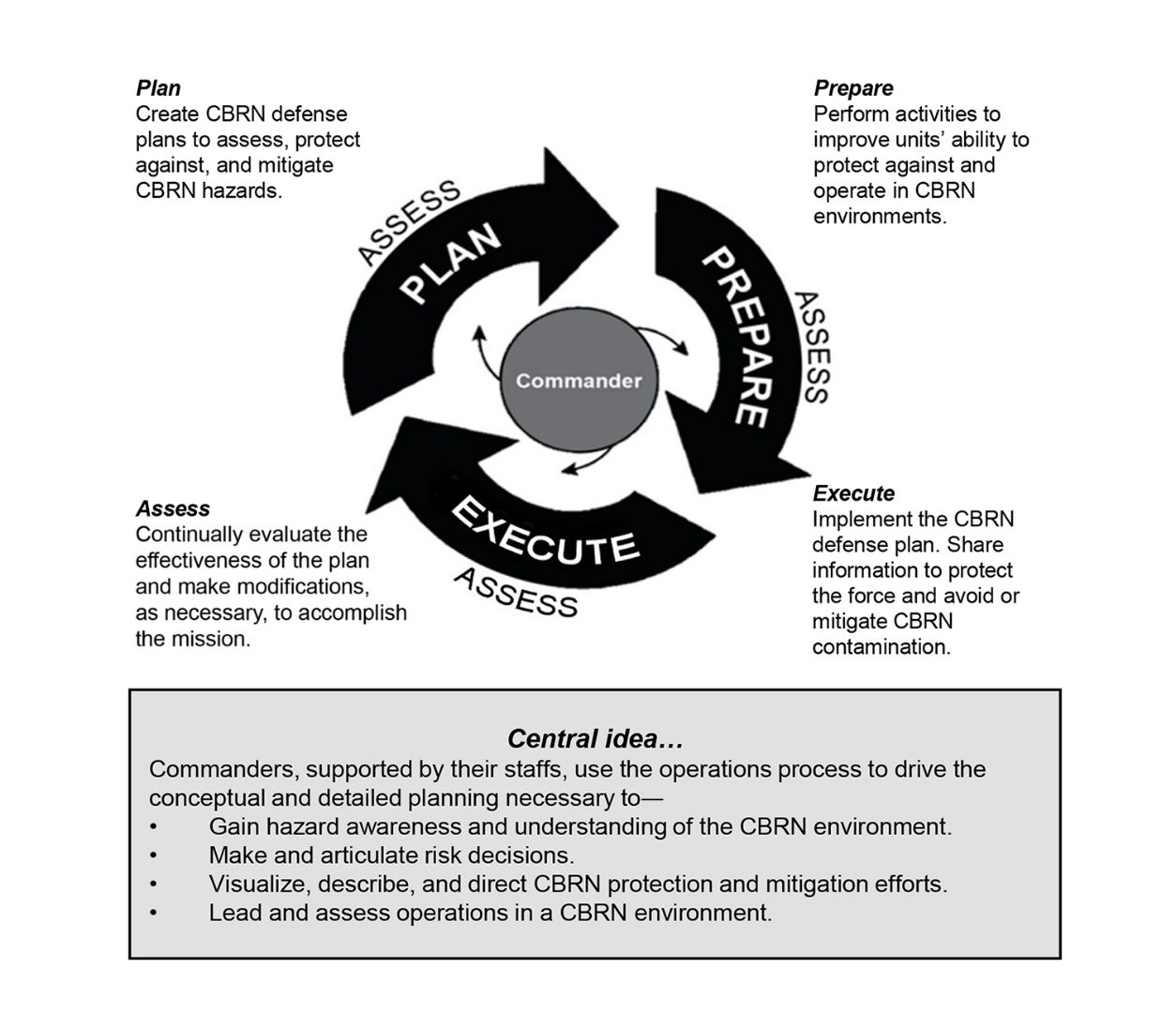by Major Derek E. Taylor
This article presents a brief description of the role of chemical, biological, radiological, and nuclear (CBRN) staff officers in the operations process. It summarizes the operations process, introduces the CBRN core functions, explains how to operationalize these core functions within the operations process, and highlights the critical CBRN staff contributions that take place during mission planning to help commanders develop hazard awareness and understanding.
Operations Process
The U.S. Army conducts multidomain operations to create and exploit relative advantages in order to achieve objectives, defeat enemy forces, and consolidate gains on behalf of joint force commanders.1 The Army framework for organizing and activating command and control is referred to as the operations process (see Figure 1).2

Commanders use the operations process to drive the conceptual and detailed planning necessary to understand an operational environment; visualize and describe the desired end state of the operation and the operational approach; make and articulate decisions; and direct, lead, and assess operations.3 Each operational environment has unique characteristics and challenges for which commanders must account. One example is a CBRN environment.
CBRN environments are operational environments that include CBRN threats and hazards and their potential effects.4 CBRN threats and hazards may shape the operational environment, disrupt lines of communication, reduce operational tempo, and degrade combat power. Additionally, CBRN operational environments may influence local populations and require increased integration with joint, interagency, multinational, and local authorities. Commanders conduct CBRN operations to address these challenges.
CBRN operations refers to “the employment of capabilities that assess, protect against, and mitigate the entire range of [CBRN] incidents to enable freedom of action.”5 These three actions of assess, protect, and mitigate constitute the CBRN core functions. Incorporating the CBRN core functions into the operations process allows commanders to prevail during CBRN operations.
CBRN Core Functions
Assessing threats and hazards is a continuous process that facilitates proactive decision making. Assessing threats and hazards includes—6
- Evaluating current hazards.
- Identifying potential threats and hazards.
- Evaluating current vulnerabilities.
- Understanding current capabilities.
- Modeling potential effects.
Protection against CBRN threats and hazards encompasses the execution of physical defenses to negate the effects of CBRN hazards on—7
- Personnel.
- Equipment.
- Installations.
- Facilities.
- Infrastructure.
Mitigation encompasses the planning and actions taken to prepare for, respond to, and recover from contamination associated with CBRN threats and hazards in order to continue military operations.8 Tasks associated with mitigation include—9•
- Defeating, disabling, or disposing of weapons of mass destruction.
- Providing scalable responses to CBRN incidents.
- Supporting reconnaissance and decontamination operations.
Commanders at every echelon possess the ability to perform the three CBRN core functions; however, CBRN forces provide commanders with an enhanced capability to perform these functions. When they incorporate CBRN core functions into the operations process, commanders gain the hazard awareness and understanding needed to make sound decisions in CBRN environments.
Core Functions and the Operations Process The operations process consists of four main activities—planning, preparing, executing, and assessing. These operations process activities are not discrete; they overlap and recur as circumstances demand (see Figure 2).

During planning, the CBRN staff conducts assessments, creates a CBRN defense plan, and models potential incidents. The result is a CBRN defense plan that is integrated with the broader mission and published in an operations order annex.10 While planning may initiate an iteration of the operations process, planning does not stop with the production of an order. After completing the initial order, the commander and staff continuously revise the plan as needed, based on changing circumstances.
Preparation for a mission often begins early during planning. To prepare, CBRN staff may recommend employing intelligence, surveillance, and reconnaissance assets to answer priority intelligence requirements.11 Additionally, subordinate units may need to check protective equipment and detectors, increase their protective posture, and conduct rehearsals. Rehearsals play an important role, as tactics, techniques, and procedures may vary during the execution of missions in CBRN environments. Finally, preparation for a follow-on mission may overlap with execution of the current mission.
Mission execution involves implementing the CBRN defense plan. Commanders assess progress and adjust the plan based on their situational understanding. CBRN defense plan tasks may include employing assets for reconnaissance, surveillance, exploitation, or decontamination. They may also include implementing targeting plans against threat units and infrastructure to reduce the likelihood of CBRN weapon employment. Real-time information sharing through warning and reporting systems helps units to avoid hazards, staffs to quickly process CBRN support requests, and commanders to appropriately assess the situation and prioritize units to receive CBRN support.12
Assessing is a continuous activity that influences the other three operations process activities.13 It involves the integration of CBRN staffs and process working groups during mission planning steps.14 CBRN reports provide input for future assessments and valuable insight into the success of CBRN defense plans.
Mission Planning
Most tactical-level staffs employ the military decision-making process, which is an iterative planning methodology used to understand the situation and mission, develop a course of action, and produce an operation plan or order. Through the military decision-making process, the staff helps the commander make informed decisions and synchronize those decisions into a fully developed plan or order.15
Throughout the decision-making process, staff officers prepare recommendations using accurate information and assessments obtained from updated running estimates within their functional areas of expertise.16 CBRN staff officers contribute to the steps of the military decision-making process by—
- Updating CBRN running estimates.
- Conducting CBRN assessments.
- Developing an initial CBRN defense plan.
- Modeling potential incidents.
- Publishing the final CBRN defense plan as an annex to the operations plan or order.
Figure 3 shows how these contributions align with each step of the military decision-making process and the CBRN core functions.

Legend:
CBRN—chemical, biological, radiological, and nuclear
COA—course of action
IPOE—intelligence preparation of the operational environment
OE—operational environment
Figure 3. CBRN contributions during mission planning
Hazard Awareness and Understanding
When properly integrated into the operations process, CBRN staffs help commanders gain hazard awareness and understanding. Commanders use this awareness and understanding to—
- Assess the operation.
- Articulate risk decisions.
- Visualize, describe, and direct CBRN protection and mitigation efforts.
- Lead the operation toward stated objectives.
Commanders and staffs use several integrating processes to adapt to changing circumstances throughout the operations process.17
Key integrating processes include—
- Intelligence preparation of the operational environment.
- Targeting.
- Knowledge management.
- Information collection.
- Risk management.
When CBRN staffs align integrating processes, unit battle rhythm events, and CBRN core functions, they contribute to improved hazard awareness and understanding throughout the operations process (see Figure 4). Ultimately, hazard awareness and understanding enables commanders to execute their portion of the operations process and prevail in CBRN environments.

Conclusion
By incorporating the CBRN core functions of assessing, protecting, and mitigating into the operations process, commanders gain hazard awareness and understanding, which ultimately enables them to visualize, describe, direct, assess, and lead their formations toward mission accomplishment and to prevail during CBRN operations.
Endnotes:
1Field Manual (FM) 3-0, Operations, 1 October 2022.
2Army Doctrine Publication (ADP) 5-0, The Operations Process, 31 July 2019.
3Ibid.
4Joint Publication (JP) 3-11, Operations in Chemical, Biological, Radiological, and Nuclear Environments,
28 October 2020.
5FM 3-11, Chemical, Biological, Radiological, and Nuclear Operations, 23 May 2019.
6Ibid.
7Ibid.
8JP 3-11.
9FM 3-11.
10Ibid.
11Ibid.
12Ibid.
13ADP 5-0.
14FM 3-11.
15ADP 5-0.
16FM 5-0, Planning and Orders Production, 16 May 2022.
17ADP 5-0.
Major Taylor is the chief of the CBRN Doctrine Branch, Doctrine Division, Fielded Force Integration Directorate, U.S. Army Maneuver Support Center of Excellence, Fort Leonard Wood, Missouri. He holds a bachelor’s degree in applied physics with minors in mathematics and philosophy from Brigham Young University, Provo, Utah, and a master’s degree in military art and science from the Army Command and General Staff College, Fort Leavenworth, Kansas.




